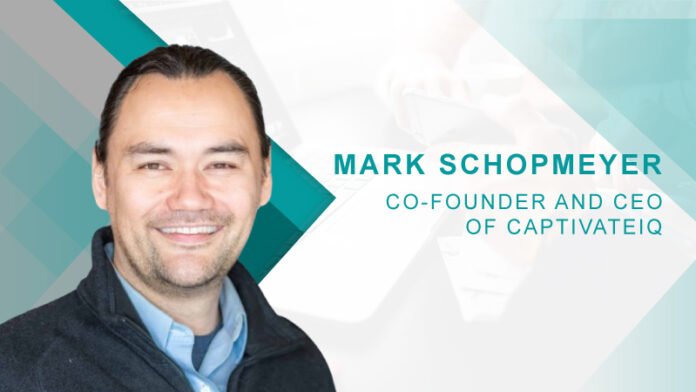Welcome to HRTech Cube, Mark. We’re excited to have you here to discuss how HR teams can rethink incentive compensation to drive better performance and business outcomes. Let’s get started.
To begin, can you please walk us through your professional journey and what inspired you to co-found CaptivateIQ?
I’m currently the Co-CEO of CaptivateIQ, where I lead our go-to-market efforts and other operational areas. Before this, my background was in finance—specifically in roles where I was responsible for managing commissions. To be honest, I dreaded it. The process was painful and outdated. Whether it was spreadsheets or legacy tools, nothing seemed designed to actually make the job easier. One vendor even told us our comp plans were “too hard,” which says a lot about the state of the industry at the time.
That frustration is really what sparked the idea behind CaptivateIQ. My co-founder and I asked ourselves: What if we built the solution we always wished we had? That’s been our guiding vision ever since—transforming a traditionally thankless process into something that’s easy, strategic, and empowering. At the core of our platform is a no-code, modeling-first approach we call SmartGrid. It combines the flexibility of spreadsheets with the structure of purpose-built software, so teams can own their comp processes without relying on outside consultants.
How has the role of incentive compensation evolved in today’s modern workplace, especially as companies focus more on performance and retention?
Incentive compensation has really shifted from being just a sales lever to something far more strategic. Today, 72% of companies plan to expand incentive compensation across departments—from marketing to HR and customer success—which speaks volumes about how performance management is evolving.
At the same time, this broader use has exposed some gaps. Fewer than one-third (30%) of companies feel their current incentive programs are very prepared for today’s economic pressures. That’s telling. Leaders are realizing that just having an incentive plan isn’t enough. It has to be adaptive, transparent, and aligned with bigger business goals. When it’s done right, it becomes a powerful tool not just for driving results, but for keeping people motivated and connected to the company’s success.
What are some of the most common mistakes you see companies make when designing or managing their incentive compensation programs?
Setting unrealistic quotas that demotivate rather than inspire. One of the most common mistakes companies make is designing compensation plans around overly ambitious, unattainable quotas. While high expectations can drive performance, failing to ground quotas in the reality of team dynamics and business structure can backfire—hurting morale and making it harder for employees to succeed. Compensation plans should be aspirational, but also achievable, so they motivate without setting people up to fail. Striking that balance is essential for both performance and retention.
Relying on outdated systems that create costly errors and inefficiencies. Many companies continue to run their incentive compensation programs on outdated or manual systems, which can severely limit their effectiveness. These legacy workflows introduce unnecessary complexity, make it difficult to scale, and often lead to expensive mistakes—like commission overpayments or underpayments. In fact, 66% of companies have experienced these kinds of payout errors in just the past year. Without modernizing these systems, companies risk undermining the very growth they’re trying to drive with incentive compensation.
How can HR teams take a more strategic approach to incentive compensation that aligns better with overall business goals?
Incentive compensation is not one-size-fits-all. Every business model is different, and an organization’s path to growth constantly evolves as new product lines, go-to-market strategies, or market expansions are prioritized. Effective incentive compensation programs consistently reflect those business priorities even as they change.
The most important aspect of incentive compensation program design is making sure it motivates the right behaviors and outcomes that align with the company’s goals, and is able to evolve as necessary.
In what ways have you seen modern compensation tools and platforms transform the relationship between incentives and employee motivation?
Visibility into potential earnings significantly increases employee motivation. In fact, 57% say working for commissions or bonuses motivates them to do a better job at work, and 52% say it motivates them to hit their goals.
Clear, transparent plans help employees understand how their efforts translate into earnings, which ultimately boosts engagement. When individuals can track their performance in real-time, forecast their potential earnings, and see how they’re doing over time and relative to peers, it creates a stronger connection between their day-to-day work and long-term goals. This kind of visibility and clarity not only motivates, but empowers employees to take ownership of their success.
Can you share any success stories or examples where strategic comp planning had a measurable impact on a company’s bottom line or growth trajectory?
Organizations that procure and allocate the appropriate amount of resources can increase profitability by 77%. A strong success story is with Gong, a fast-growing revenue AI platform. Through incentive compensation planning with CaptivateIQ, they increased payout accuracy to 98%+ and increased the speed of monthly commission calculations by 60x.
How should organizations think about flexibility and personalization in incentive plans—especially with a diverse, multi-generational workforce?
One of the smartest steps companies can take is to design more flexible, goal-oriented incentive programs that go beyond just hitting quota. Compensation planning should be a cross-functional effort — not something done in isolation. By regularly reviewing plans and aligning metrics to the specific goals of each role, organizations can better reward the behaviors that truly drive long-term growth, such as pipeline generation, customer satisfaction, or product engagement (not what is just “easy to track”).
What’s your personal strategy for ensuring compensation plans not only drive performance but also maintain fairness and transparency?
We’ve learned from our 2025 Incentive Compensation Report that incentive comp programs are most effective when they are easy to understand, but many organizations still struggle with issues around data accuracy, visibility, and communication. As teams look to improve trust, transparency, and revenue results, AI and real-time insights are becoming essential tools for reducing confusion and surfacing what matters most.
Especially in uncertain times, incentive compensation remains one of the most effective tools for aligning performance with business priorities. Reviewing and adjusting plans more frequently correlates with higher revenue performance: companies reviewing performance weekly versus annually reported almost 2x significant growth.
What advice would you give to HR and finance leaders who are looking to modernize their incentive compensation models but don’t know where to start?
First, pat yourself on the back for recognizing the benefits of ICM and taking the leap to implement into your organization.
Start by tackling the most immediate wins: automate the admin-heavy tasks first. Our report shows that teams spend roughly 89 hours a month on manual processes – automation not only saves time and money, but also cuts errors by nearly half.
Once you’ve reclaimed that bandwidth, make incentive visibility a priority. Only about half of companies share real-time earnings data with their teams – leaders who give reps clear, live insights into their performance unlock trust, motivation, and accountability.
Next, tie rewards to outcomes that matter, not just revenue numbers. Whether it’s pipeline growth, customer satisfaction, or product adoption, incentives should reinforce strategic goals – 59% of organizations say they use comp to drive broader business objectives.
Then, build a strong business case for change. Highlight cost savings, more accurate payouts, and faster reporting. These are the metrics that get buy-in from executives.
Finally, don’t treat your comp program as set-it-and-forget-it. Only 35% of companies review plans quarterly – but those that do see up to three times more revenue growth. Keep tweaking as your business evolves.
Finally, any thoughts you’d like to share with readers on how incentive compensation can become a true lever for business success in the years ahead?
The current business landscape is pushing companies to rethink long-held assumptions around how they motivate and reward talent. We’re seeing a new wave of more agile, performance-based approaches in organizations that better reflect today’s dynamic environment.
When done right, incentive compensation can help teams focus on the outcomes that matter most, align individual effort with business goals, and support a culture of accountability and performance. But success isn’t just about tying pay to results. It’s about building plans that are transparent, flexible, and well-communicated.
Amid ongoing market uncertainty, sales planning cycles are becoming shorter and targets are constantly in flux—so businesses need sales performance processes that can adapt quickly. At the same time, employees want to understand how they’re being measured and rewarded. That’s why it’s so important to take an incremental, thoughtful approach with incentive compensation. If the goal posts shift, keep employees informed, encourage feedback, and make sure they feel supported throughout any changes.
When incentive compensation is aligned with business strategy and communicated clearly, it becomes more than just a payroll function – it becomes a strategic driver of growth, efficiency, and long-term success.

Mark Schopmeyer co-founder and CEO of CaptivateIQ
Mark Schopmeyer is the co-founder and co-CEO of CaptivateIQ, a sales performance management (SPM) platform he founded after spending too many years managing and tracking sales commissions in spreadsheets. Through CaptivateIQ, he now helps hundreds of go-to-market teams optimize their compensation and sales planning strategies.












